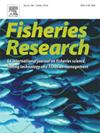Impacts of different types of data integration on the predictions of spatio-temporal models: A fishery application and simulation experiment
IF 2.2
2区 农林科学
Q2 FISHERIES
引用次数: 0
Abstract
Integrated spatio-temporal models, which enable the sharing of information across locations, time and data sources, are gaining traction for their potential to generate more precise and more accurate estimations compared to models fitted to single data sources. Standard integrated spatio-temporal models combine multiple data sources via a catchability factor. Recently, spatially varying catchability (SVC) integrated spatio-temporal models were developed to implement data integration via the estimation of an SVC term for the least reliable data sources. Expanded-domain integrated spatio-temporal models are models integrating data from different spatial areas. Spatio-temporal models can combine standard or SVC integrated modelling with expanded-domain integrated modelling. The above-mentioned types of data integration have never been evaluated through a comparative analysis. Here, we investigate the impacts of these different types of data integration on the predictions of spatio-temporal models, via an application to the southern hake (Merluccius australis) HAK4 stock, where the bottom trawl data collected within the New Zealand observer programme are integrated with data from five different bottom trawl research surveys, and a simulation experiment. In total, six models were compared in the present study, where the three last models constitute expanded-domain integrated models: (Model 1) a model fitted to observer-only data for HAK4; (Model 2) a standard integrated model fitted to both observer and survey data for HAK4; (Model 3) an SVC integrated model fitted to both observer and survey data for HAK4; (Model 4) a model fitted to observer-only data for HAK4 and the other New Zealand hake stocks (HAK1 and HAK7); (Model 5) a standard integrated model fitted to both observer and survey data for HAK4, HAK1 and HAK7; and (Model 6) an SVC integrated model fitted to both observer and survey data for HAK4, HAK1 and HAK7. For the simulation experiment, we produced simulated data from Model 5, fitted the six models to the simulated data, and evaluated the performance of the models by comparing their estimations to the simulated data. Overall, the indices obtained with the different types of integrated models outperformed the indices obtained with models using observer-only data: indices from the integrated models were more precise, better matched the traditional stratified random index and had less bias and a smaller root-mean-squared-error, yet characterised uncertainty less well. Moreover, expanded-domain integrated models outperformed other models regarding habitat assessments: (1) they provided insights into spatial density patterns for much larger regions and predicted these patterns more precisely for the area common to all models; and (2) models combining expanded-domain integrated modelling with standard or SVC integrated modelling predicted patterns of distribution shifts and range expansion/contraction more precisely than the expanded-domain integrated model employing observer-only data. Finally, expanded-domain integrated models did not outperform other integrated models regarding supporting stock assessments. The indices obtained with expanded-domain integrated models were more precise and had less bias and a smaller root-mean-squared-error, but agreed less with the traditional stratified random index and characterised uncertainty less well. This result suggests that standard or SVC integrated models should be preferred to produce indices for local areas.
不同类型数据整合对时空模型预测的影响:渔业应用与模拟实验
综合时空模型能够实现跨地点、时间和数据源的信息共享,与适用于单一数据源的模型相比,其产生更精确和更准确估算的潜力正受到越来越多的关注。标准集成时空模型通过可捕获性因子将多个数据源组合在一起。近年来,发展了空间变化可捕获性(SVC)集成时空模型,通过估计最不可靠数据源的SVC项来实现数据集成。扩展域集成时空模型是将不同空间区域的数据集成在一起的模型。时空模型可以将标准或SVC集成建模与扩展域集成建模相结合。上述类型的数据集成从未通过比较分析进行评估。在这里,我们研究了这些不同类型的数据整合对时空模型预测的影响,通过对南鳕(Merluccius australis) HAK4种群的应用,在新西兰观察员计划中收集的底拖网数据与来自五个不同底拖网研究调查的数据相结合,并进行了模拟实验。本文共比较了6个模型,其中后3个模型构成了扩展域集成模型:(模型1)仅拟合观察者数据的HAK4模型;(模型2)HAK4观测数据和观测数据的标准综合模型;(模型3)HAK4观测数据和观测数据的SVC综合模型;(模型4)对HAK4和其他新西兰鳕鱼种群(HAK1和HAK7)的观察者数据拟合的模型;(模型5)对HAK4、HAK1和HAK7观测数据和观测数据进行拟合的标准综合模型;和(模型6)对HAK4、HAK1和HAK7观测数据和观测数据均拟合的SVC综合模型。在模拟实验中,我们从模型5中生成模拟数据,将六个模型拟合到模拟数据中,并通过与模拟数据的比较来评估模型的性能。总体而言,使用不同类型的综合模型获得的指数优于使用仅观察者数据的模型获得的指数:综合模型获得的指数更精确,与传统的分层随机指数更匹配,偏差更小,均方根误差更小,但表征不确定性的能力较差。此外,扩展域集成模型在生境评估方面优于其他模型:(1)它们提供了对更大区域的空间密度格局的见解,并更准确地预测了所有模型共同区域的空间密度格局;(2)扩展域集成模型与标准或SVC集成模型相结合的模型比仅使用观察者数据的扩展域集成模型更准确地预测分布位移和范围扩展/收缩模式。最后,扩展域集成模型在支持存量评估方面并不优于其他集成模型。扩展域综合模型得到的指标精度更高,偏差更小,均方根误差更小,但与传统的分层随机指标的一致性较差,表征不确定性的效果较差。这一结果表明,应优先采用标准模型或SVC综合模型来生成局部区域的指标。
本文章由计算机程序翻译,如有差异,请以英文原文为准。
求助全文
约1分钟内获得全文
求助全文
来源期刊

Fisheries Research
农林科学-渔业
CiteScore
4.50
自引率
16.70%
发文量
294
审稿时长
15 weeks
期刊介绍:
This journal provides an international forum for the publication of papers in the areas of fisheries science, fishing technology, fisheries management and relevant socio-economics. The scope covers fisheries in salt, brackish and freshwater systems, and all aspects of associated ecology, environmental aspects of fisheries, and economics. Both theoretical and practical papers are acceptable, including laboratory and field experimental studies relevant to fisheries. Papers on the conservation of exploitable living resources are welcome. Review and Viewpoint articles are also published. As the specified areas inevitably impinge on and interrelate with each other, the approach of the journal is multidisciplinary, and authors are encouraged to emphasise the relevance of their own work to that of other disciplines. The journal is intended for fisheries scientists, biological oceanographers, gear technologists, economists, managers, administrators, policy makers and legislators.
 求助内容:
求助内容: 应助结果提醒方式:
应助结果提醒方式:


